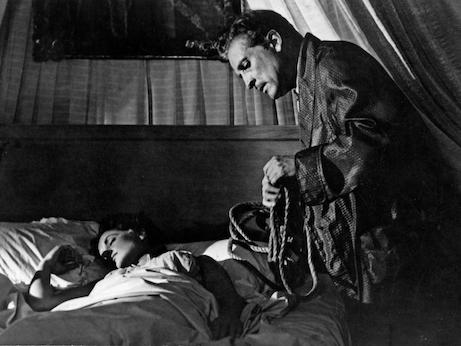ÉL: A Forgotten Buñuel Gem Returns

Luis Buñuel's ÉL
These notes on Luis Buñuel's Él were written by John Bennett, PhD candidate in the Department of Communication Arts at UW Madison and project assistant for the UW Cinematheque. A new restoration of Él from the Cineteca di Bologna will screen as part of our current series highlighting the best of last summer's Il Cinema Ritrovato festival, on Saturday, March 18, at 7 p.m., in the Cinematheque's regular venue, 4070 Vilas Hall, 821 University Avenue. Admission is free!
By John Bennett
With the opening images of Él, famed surrealist auteur Luis Buñuel immediately draws us into his unique brand of irreverence and perversity. A priest leads a religious ritual in which parishioners’ feet are washed. As the camera tracks into a close-up, we see the priest gingerly kiss a foot he has just finished washing (an image that echoes actress Lya Lys kissing a statue’s toe in L’Age d’or, Buñuel’s first surreal bacchanalian feature). One parishioner’s roving eye wanders to a pew filled with women. As he appraises their high-heeled shoes, Buñuel subtly profanes imagery that had glowed with religious sanctity just moments before. The leering churchgoer is Francisco Galván de Montemayor (Arturo de Córdova), a suave, patrician man who becomes enamored with a woman named Gloria (Delia Garcés). Gloria, in turn, quickly comes to find Francisco’s suave confidence—as well as his prominent social position—alluring. The two hastily wed soon after their first meeting. On the very first night of their marriage, however, Francisco reveals his horrible flaw: he is possessed by a jealousy so monstrous that it makes Othello seem saintly by comparison. Gloria soon realizes that this outsized jealousy manifests itself in increasingly ludicrous ways. A stranger laughing with a waiter at a hotel restaurant is enough of a stimulus to throw Francisco into a petulant rage. As Él plays out, Gloria desperately tries to find ways to escape her husband’s chronic paranoia.
Buñuel is best remembered as one of world cinema’s most playful and puckish surrealists. In his early period, his filmic surrealism sprung from the world of visual art. His first scandalous short, Un chien andalou (1929), was co-written by Salvador Dalí, and L’Age d’or (1930) elaborated the short’s disorienting techniques and shocking imagery into a feature length work. His late period, best represented by dramas like Belle de Jour (1966) or comedies like The Discreet Charm of the Bourgeoisie (1972), deployed a dreaminess that followed in the wake of the oneiric arthouse classics by filmmakers like Fellini and Bergman. Él, however, falls squarely in the director’s middle period, during which he made films for the Mexican film industry after fleeing his native Spain during the Spanish Civil War. Here, Buñuel remained ever the surrealist, but industry demands forced his flights of fancy to be more clearly integrated into his films’ narratives. Such is the case with Él, whose strange set pieces are intelligibly embedded within the film’s story world. In one particularly wacky sequence, a frenzied Francisco wanders into a church; here, shots depicting churchgoers sitting piously in their pews are intercut with sudden shots of those same parishioners laughing wildly at Francisco as an echoing cacophony of laughter rings out on the soundtrack. Here, unlike Buñuel’s first and final films, the surrealism is motivated by the narrative: we take these strange jump cuts as expressions of Francisco’s all-consuming paranoia and deteriorating mental state.
Also of a piece with Buñuel’s larger filmography is the obsessiveness of Él’s protagonist. Across the many phases of his career, Buñuel seemed to revel in the foolishness of male characters driven to passionate extremes by desire or hate. Francisco, in all his manic jealousy, bears a strong resemblance to the frantic characters played by Fernando Rey in notable Buñuel titles such as 1961’s Viridiana (in which a man becomes infatuated with his niece—who happens to be a nun), 1970’s Tristana (in which a Spanish nobleman becomes enamored with a young orphaned woman in his charge), or 1977’s That Obscure Object of Desire (wherein a man obsesses over a young woman surreally portrayed by two different actresses). With this character type, Buñuel manages to create men who are both repulsive and, in their own buffoonish way, humorous. The reprehensible Francisco frequently behaves with brutish roughness toward his wife, and, in one harrowing sequence, worse violence is hinted to be taking place off screen. This moral turpitude takes on a grimly humorous hue when, by the film’s ironic coda, we realize how stubbornly, idiotically inflexible Francisco’s paranoid convictions are. Like so many men in Buñuel’s subsequent films, Francisco is a villain to be scorned as much as he is a clown to be derided.
Given Buñuel’s status as a globetrotting, visionary filmmaker (he worked in France, Mexico and Spain, and he even lived for a period in the United States), one may be tempted to see Él as an anomalous entry in Mexican cinema. But the film, with its emotional extremes and its imperiled heroine, can be considered of a piece with the melodramas that the Mexican film industry produced regularly at the height of its economic power in the 1950s. Él is barely more extreme than, say, Alberto Gout’s wildly over-the-top The Adventuress (1950). Yet even if it was in keeping with certain Mexican filmmaking traditions, the film flopped at home and abroad. In My Last Sigh, his autobiography, Buñuel notes that Él played theatrically for less than a month in Mexico. On the festival circuit, the film received a chilly reception at Cannes. In a moment of absurdism worthy of a Buñuel film, Él was met with an unappreciative audience at a special screening for French veterans of foreign wars, and Jean Cocteau—Buñuel’s surrealist-in-arms—was vocally hostile toward the film. Nevertheless, its reputation has enjoyed a rehabilitation over the decades, with the film now considered to be—alongside The Criminal Life of Archibaldo de la Cruz (1955) and The Exterminating Angel (1962)—one of the best films of Buñuel’s Mexican period.
